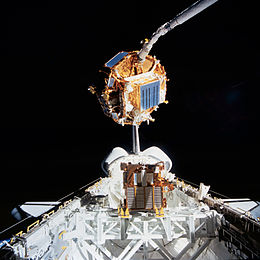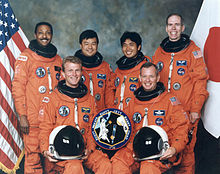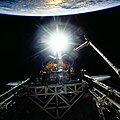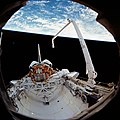STS-72
 Endeavour'sCanadarm captures the Space Flyer Unit | |
| Mission type | Satellite retrieval Research |
|---|---|
| Operator | NASA |
| COSPAR ID | 1996-001A |
| SATCATno. | 23762 |
| Mission duration | 8 days, 22 hours, 01 minutes, 47 seconds |
| Distance travelled | 6,000,000 kilometres (3,700,000 mi) |
| Orbits completed | 142 |
| Spacecraft properties | |
| Spacecraft | Space ShuttleEndeavour |
| Launch mass | 112,182 kilograms (247,319 lb) |
| Landing mass | 98,549 kilograms (217,263 lb) |
| Payload mass | 6,510 kilograms (14,350 lb) |
| Crew | |
| Crew size | 6 |
| Members | |
| Start of mission | |
| Launch date | 11 January 1996, 09:41:00.072UTC |
| Launch site | KennedyLC-39B |
| End of mission | |
| Landing date | 20 January 1996, 07:41:41UTC |
| Landing site | KennedySLF Runway 15 |
| Orbital parameters | |
| Reference system | Geocentric |
| Regime | Low Earth |
| Perigee altitude | 185 kilometres (115 mi) |
| Apogee altitude | 470 kilometres (290 mi) |
| Inclination | 28.45 degrees |
| Period | 91.1 min |

 Left to right - Seated: Jett, Duffy; Standing: Scott, Chiao, Wakata, Barry | |
STS-72was aSpace ShuttleEndeavourmission to capture and return to Earth a Japanese microgravity research spacecraft known asSpace Flyer Unit(SFU). The mission launched fromKennedy Space Center,Florida on 11 January 1996.
Crew
[edit]| Position | Astronaut | |
|---|---|---|
| Commander | Third spaceflight | |
| Pilot | First spaceflight | |
| Mission Specialist 1 | Second spaceflight | |
| Mission Specialist 2 | First spaceflight | |
| Mission Specialist 3 | First spaceflight | |
| Mission Specialist 4 | First spaceflight | |
Crew seating arrangements
[edit]| Seat[1] | Launch | Landing | 
Seats 1–4 are on the Flight Deck. Seats 5–7 are on the Middeck. |
|---|---|---|---|
| S1 | Duffy | Duffy | |
| S2 | Jett | Jett | |
| S3 | Chiao | Wakata | |
| S4 | Scott | Scott | |
| S5 | Wakata | Chiao | |
| S6 | Barry | Barry |
Spacewalks
[edit]- Chiao and Barry– EVA 1
- EVA 1 Start:15 January 1996 – 05:35 UTC
- EVA 1 End:15 January – 11:44 UTC
- Duration:6 hours, 9 minutes
- Chiao and Scott– EVA 2
- EVA 2 Start:17 January 1996 – 05:40 UTC
- EVA 2 End:17 January – 12:34 UTC
- Duration:6 hours, 54 minutes
Mission highlights
[edit]STS-72, the 74th flight of the Space Shuttle program and the 10th of the orbiterEndeavourwas launched at 4:41AM EST 11 January 1996 after a brief hold at the T-5-minute mark due to communication issues. The nighttime launch window was in support of the mission's primary objective, the capture and return to Earth of a Japanese microgravity research spacecraft known asSpace Flyer Unit(SFU). The 3,577 kilograms (7,886 lb) SFU was launched by Japan'sNational Space Development Agency(NASDA) fromTanegashima Space Centerin Japan on 18 March 1995 aboard a Japanese H-II rocket (HII-3), and spent ten months in orbit conducting automated research in materials science, biology, engineering, and astronomy. Mission Specialist Koichi Wakata operated the orbiter's remote manipulator system arm on flight day three to pluck SFU from orbit. Both of the satellite's solar arrays had to be jettisoned prior to retrieval when sensors indicated improper latching following their retraction. This jettison procedure had been incorporated in preflight training as a contingency in the event of such an occurrence. The canisters housing the arrays were jettisoned 12 minutes apart asEndeavourand the SFU traveled across Africa on the thirtieth orbit of the mission. The contingency procedure delayed the capture of the satellite by about an hour and half. Once inEndeavour's payload bay, the satellite's internal batteries were bypassed following connection of a remotely operated electrical cable to the side of the satellite.[2]On this mission,Daniel T. Barryand Japanese astronautKoichi Wakatawere the first people to playGoin space; for this achievement, both Barry and Wakata received the honorary awards of Ni Dan rank by theNihon Kiinmaking Barry one of only four Western Go players to receive such an award. Barry and Wakata used a special Go set, which was named Go Space, designed by Wai-Cheung Willson Chow.[3]
OAST-Flyer
[edit]
The STS-72 mission also flew with the Office of Aeronautics and Space Technology Flyer (OAST-Flyer) spacecraft. OAST-Flyer was the seventh in a series of missions aboard the reusable free-flying Spartan carrier spacecraft series. It consisted of four experiments: Return Flux Experiment (REFLEX) to test accuracy of computer models predicting spacecraft exposure to contamination;Global Positioning SystemAttitude Determination and Control Experiment (GADACS) to demonstrate GPS technology in space; Solar Exposure to Laser Ordnance Device (SELODE) to test laser ordnance devices;Spartan Packet Radio Experiment(SPRE) and theAmateur Radio Associationat theUniversity of Maryland(W3EAX) amateur radio communications experiment. On flight day four, Wakata again operated Endeavour's robot arm to deploy the Spartan, sending the experiment-laden platform on its way to a 50-hour free-flight at a distance of approximately 45 miles (72 kilometers) from the orbiter. OAST-Flyer was retrieved on flight day six, with Wakata again operating the remote manipulator system arm to retrieve the platform.[4]
Spacewalks
[edit]
Two 6.5-hour spacewalks were conducted by three astronauts to test hardware and tools to be used in the assembly of theInternational Space Stationstarting in late 1998. EVA-1 on flight day five consisted of Crewmembers Leroy Chiao (EV1) and Dan Barry (EV2). After taking a few minutes to acclimate themselves in the payload bay, first-time spacewalkers Chiao and Barry attached a portable work platform to the end of the robot arm, operated by Pilot Brent Jett and Mission Specialist Koichi Wakata. Jett used the arm to grapple various pieces of hardware designed to hold large modular components, mimicking the way equipment boxes and avionics gear will be moved back and forth in assembling the Space Station.
Chiao and Barry then unfolded a cable tray diagonally across the forward portion of the cargo bay housing simulated electrical and fluid lines similar to those which would later connect modules and nodes of the Space Station. The rigid umbilical, as it is known, was tested for its ease of handling and the ability of the astronauts to hook up the lines to connectors on the side of Endeavour's bay. While Chiao unraveled various lengths of cable from a caddy device, Barry spent time practicing the hookup of the various cables in the rigid umbilical to connectors in the bay, testing his ability to manipulate tiny bolts and screws in weightlessness. He reported that most tasks could be accomplished with little difficulty. Barry and Chiao then traded places, as Barry mounted the portable work platform to evaluate its worth. The first EVA lasted 6 hours, 9 minutes.[5]EVA-2 on Flight Day 7 consisted of Leroy Chiao (EV1) and Winston Scott (EV2), lasting 6 hours, 53 minutes. Chiao and Scott worked with utility boxes, slidewires and a portable work stanchion affixed toEndeavour's robot arm to gather additional data on methods and procedures which would be incorporated in the techniques used to assemble the International Space Station. Late in the spacewalk, Scott climbed into foot restraints on the OAST-Flyer satellite platform for a thermal evaluation exercise.Endeavourwas maneuvered to the coldest position possible, with its payload bay facing out toward deep space and allowing temperatures to dip to about 104 degrees below zero at the point where Scott was positioned to test the ability of his spacesuit to repel the bitter cold temperature of space.[6]
Additional payloads
[edit]Other experiments onboard STS-72 included the Shuttle Solar Backscatter Ultraviolet Experiment (SSBUV-8) (previously flown onSTS-34,STS-41,STS-43,STS-45,STS-56,STS-62andSTS-66), EDFT-03, Shuttle Laser Altimeter Payload (SLA-01/GAS(5)), VDA-2,National Institutes of HealthNIH-R3 Experiment, Space Tissue Loss Experiment (STL/NIH-C), Pool Boiling Experiment (PBE) (hardware previously flown onSTS-47,STS-57andSTS-60) and the Thermal Energy Storage (TES-2) experiment (previously flown onSTS-69). Get Away Specialpayloads included theUnited States Air Force AcademyG-342 Flexible Beam Experiment (FLEXBEAM-2), Society of Japanese Aerospace Companies' G-459 – Protein Crystal Growth Experiment and theJet Propulsion LaboratoryGAS Ballast Can with Sample Return Experiment.
Documentary
[edit]The crew of STS-72 and their families were followed by a camera crew fromPBSfrom the day they were assigned to the flight and then through their training and, finally, the mission itself. The result was a 90-minute documentary narrated byBill NyetitledAstronautswhich first aired on PBS on 17 July 1997 and was later released on VHS home video.
In December 2020, photographer John Angerson released unseen photos of mission preparation.[7]
Image Gallery
[edit]-
Endeavouron Pad 39B.
-
Endeavourlaunching on STS-72.
-
Traditional inflight crew portrait.
-
Space Flyer Unit on approach.
-
SFU after panel jettison.
-
MS Koichi Wakata on the flight deck.
-
STS-72 Commander Duffy.
-
Dan Barry and Koichi Wakata playingGoon the middeck.
-
Spartan visible out the windows.
-
Sunburst overEndeavour.
-
Mt. Kilimanjaro from orbit.
-
Dan Barry works with the rigid umbilical.
-
Winston Scott during EVA 2.
-
Space ShuttleEndeavourlanding after a successful flight.
See also
[edit]- List of human spaceflights
- List of Space Shuttle missions
- Outline of space science
- Space Shuttle
- Spartan Packet Radio Experiment
External links
[edit]- NASA mission summaryArchived20 December 2016 at theWayback Machine
- STS-72 Video HighlightsArchived10 November 2013 at theWayback Machine
Notes
[edit]- ^"Spaceflight mission report: STS-72".www.spacefacts.de.Retrieved25 April2024.
- ^STS-72 Status Report # 5,MCC,1996
- ^Peng, Mike; Hall, Mark (1996)."One Giant Leap For Go, or Astronauts Find Life in Space"(PDF).Svensk Go Tidning.1996(2): 8–9. Archived fromthe original(PDF)on 5 October 2016.Retrieved13 August2020.
- ^STS-72 Status Report # 8,MCC,1996
- ^STS-72 Status Report # 7,MCC,1996
- ^STS-72 Status Report # 9,MCC,1996
- ^"Inside Nasa: unseen photos of astronauts training for a mission".Financial Times.19 December 2020. p. 1.ISSN0307-1766.Archived fromthe originalon 10 December 2022.Retrieved23 November2021.















